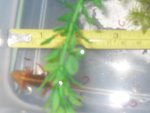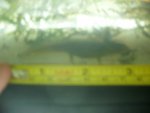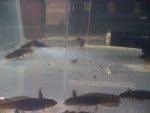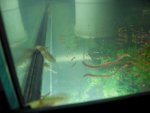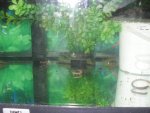mr cyclone
Active member
- Joined
- Mar 14, 2010
- Messages
- 570
- Reaction score
- 39
- Points
- 28
- Location
- Edinburgh Scotland
- Country
- Scotland
I have been raising Verrucoses Larvae since february, And as of August Shanjing larvae both species from eggs.
There have been various discussions and threads over the best methods.My method may differ slightly from most conventional.The purpose of my experiments were to see if I could manipulate the conditions to raise larvae for the following reasons:
1) To see if warmer or colder temperatures yield larger Morphs
2) To see if water depth and space is crucial for yielding smaller or larger Morphs
3) What key conditions are required for Neotony or faster Metamorphosis
I DO NOT IN ANY WAY RECOMMEND MIXING SPECIES UNLESS YOU KNOW WHAT YOU ARE DOING,AS 99 TIMES OUT OF 100 IT WILL END IN TEARS.
MY NOTES BELOW ARE MY EXPERIENCE WITH THE VERRUCOSES AND SHANJING
Anyway
Ive now raised in excess of 80 Verrucoses Morphs and only 4 Shanjing this year but my theories and proof are below.
1) group 1 were raised on a windows recieving daylight but not direct sunlight,this group of 10 eggs were raised in water depth of 2 inches and in a tub of 12 inches x 4inches.This setup was kept at 20 to 22C .And yielded 3 Morphs measuring at 1 inch.
2) group 2,3,4,5 were all raised in large tubs measuring at 12 inches x 36 inches at a water depth of 10 inches
group 2 and 3 were kept at 26C with a heater,filter and aquatic plants
group 3 and 4 were kept at 18 to 20C with a heater,filter and aquatic plants
All from groups 2/3/4/5 had 10 larvae in each container
group 2 and 3 morphed in 3 to 4 months at around 3 to 4 inches
these were eating a phenomenal amount of food feeding every day
group 3 and 4 morphed in 5 months at around 2 to 3 inches
these animals were being fed every 2 days and were eating 1/3 of the animals above.
I had several issues to begin with with the warm water temps at 26C , i had fungus in the tubs/tanks ,plants were rotting the daphnia and bloodworms were dieing and polluting the water ,It's then when i added a filter that broke the water surface and ran off a stone as too minimise gas bubble disease(lost several larvae to swallowing bubbles).I lost larvae to canabilism,bloat,ammonia,gas bubbles,stress.Once the verrucoses were starting to gain their newt colours i decided to reduce the water depth to 6 inches and placed the 2 tubs from group 2 and 3 into a large aquarium i maintained the water temperature at 26C.
Up untill now i believed warmer temps reared larger morphs.
At the moment I'm rearing 8 verrucoses left from eggs i kept back from my adults,I originally threw the eggs into my Triturus tank to use as feeders,seem's like a terrible waste I know (I had around 3000 eggs this year and couldn't give them away).
It wasnt untill I spotted a very large verrucoses larvae in the tank with the Marms and Cristatus hoovering up the bloodworms.I looked around for traces of the eggs i threw in and spotted around 10 larvae.The larvae had toughed it out untill now i decided to withdraw 2 large larvae and place them in a small tub i use for morphing,Ive also got 6 or 7 smaller verrucoses larvae still in the tank with the triturus and also 2 shanjing.
#( I DO NOT BELIEVE IN TRITURUS AND TYLOTOTRITON AS TANK MATES)
Remember these were feeders originally,
As it goes the newts inquisitively swim up to the larvae bump them with their nose and then swim away,the 2 verrucoses monsters I removed are at the stage where their mouths are the same size as the Triturus.
I also recieved 6 shanjing eggs from a good friend to rear,The Shanjing seem to be less verocious than their relative verrucoses,and morph faster and smaller,2 larvae died my next 2 Shanjing morphed fast in 4 inches of water at 18C at 1 inch.I decided after this to try and morph the last 2 Shanjing as largely as possible so
the 2nd 2 are still to morph and were relocated to the Triturus tank like the verrucoses at a water depth of 10 inches .A very risky gamble I admit! (In the interest of science lol)
Any way my 2 large verrucoses that have been fished out into a seperate tub are now in their to morph
The 2 shanjing are still in Their but are already larger as larvae then the 7 shanjing juves i have CB2012
This shows water depth and space for them to swim about plays a crucial part in larger morphs,theyve got less motivation to leave the water if foods abundant and no-one is trying to eat them(Turns out my Cristatus and Marms are quite snobbish in what they eat live bloodworm and whiteworm mostly and shying away from lob,dendrobena ,waxworms,daphnia and frozen food)They've never paid any attention to the verrucoses or shanjing.Once the other larvae start to colour up i will remove them from the tank as to save them from drowning and any disasters happening between interspecies toxins etc.
Once the larvae reach a good size and are beginning to come to the surface to breathe ,I make it easier for them to breach the surface with protruding rocks or to a setup with lower water depth.
Ive found warmer temperatures and deep water yield hungry animals that will grow fast and large ,but may age the animals significantly(1 such larvae refused to morph and morphed at 6 inches fully aquatic mature male at 9months old) Warm temperatures and shallow water speed up metamorphosis,but may not be as safe as you may compromise the water quality.
Water depth and space ,not warm temperature seems to be the key factor for rearing the largest larvae ,once they are to a suitable size then can you lower the water depth and trigger morphing
Verrucoses given the chance will remain neotonic if the water conditions are deep enough.
Shanjing morph smaller than verrucoses but similar conditions do help yield size
There have been various discussions and threads over the best methods.My method may differ slightly from most conventional.The purpose of my experiments were to see if I could manipulate the conditions to raise larvae for the following reasons:
1) To see if warmer or colder temperatures yield larger Morphs
2) To see if water depth and space is crucial for yielding smaller or larger Morphs
3) What key conditions are required for Neotony or faster Metamorphosis
I DO NOT IN ANY WAY RECOMMEND MIXING SPECIES UNLESS YOU KNOW WHAT YOU ARE DOING,AS 99 TIMES OUT OF 100 IT WILL END IN TEARS.
MY NOTES BELOW ARE MY EXPERIENCE WITH THE VERRUCOSES AND SHANJING
Anyway
Ive now raised in excess of 80 Verrucoses Morphs and only 4 Shanjing this year but my theories and proof are below.
1) group 1 were raised on a windows recieving daylight but not direct sunlight,this group of 10 eggs were raised in water depth of 2 inches and in a tub of 12 inches x 4inches.This setup was kept at 20 to 22C .And yielded 3 Morphs measuring at 1 inch.
2) group 2,3,4,5 were all raised in large tubs measuring at 12 inches x 36 inches at a water depth of 10 inches
group 2 and 3 were kept at 26C with a heater,filter and aquatic plants
group 3 and 4 were kept at 18 to 20C with a heater,filter and aquatic plants
All from groups 2/3/4/5 had 10 larvae in each container
group 2 and 3 morphed in 3 to 4 months at around 3 to 4 inches
these were eating a phenomenal amount of food feeding every day
group 3 and 4 morphed in 5 months at around 2 to 3 inches
these animals were being fed every 2 days and were eating 1/3 of the animals above.
I had several issues to begin with with the warm water temps at 26C , i had fungus in the tubs/tanks ,plants were rotting the daphnia and bloodworms were dieing and polluting the water ,It's then when i added a filter that broke the water surface and ran off a stone as too minimise gas bubble disease(lost several larvae to swallowing bubbles).I lost larvae to canabilism,bloat,ammonia,gas bubbles,stress.Once the verrucoses were starting to gain their newt colours i decided to reduce the water depth to 6 inches and placed the 2 tubs from group 2 and 3 into a large aquarium i maintained the water temperature at 26C.
Up untill now i believed warmer temps reared larger morphs.
At the moment I'm rearing 8 verrucoses left from eggs i kept back from my adults,I originally threw the eggs into my Triturus tank to use as feeders,seem's like a terrible waste I know (I had around 3000 eggs this year and couldn't give them away).
It wasnt untill I spotted a very large verrucoses larvae in the tank with the Marms and Cristatus hoovering up the bloodworms.I looked around for traces of the eggs i threw in and spotted around 10 larvae.The larvae had toughed it out untill now i decided to withdraw 2 large larvae and place them in a small tub i use for morphing,Ive also got 6 or 7 smaller verrucoses larvae still in the tank with the triturus and also 2 shanjing.
#( I DO NOT BELIEVE IN TRITURUS AND TYLOTOTRITON AS TANK MATES)
Remember these were feeders originally,
As it goes the newts inquisitively swim up to the larvae bump them with their nose and then swim away,the 2 verrucoses monsters I removed are at the stage where their mouths are the same size as the Triturus.
I also recieved 6 shanjing eggs from a good friend to rear,The Shanjing seem to be less verocious than their relative verrucoses,and morph faster and smaller,2 larvae died my next 2 Shanjing morphed fast in 4 inches of water at 18C at 1 inch.I decided after this to try and morph the last 2 Shanjing as largely as possible so
the 2nd 2 are still to morph and were relocated to the Triturus tank like the verrucoses at a water depth of 10 inches .A very risky gamble I admit! (In the interest of science lol)
Any way my 2 large verrucoses that have been fished out into a seperate tub are now in their to morph
The 2 shanjing are still in Their but are already larger as larvae then the 7 shanjing juves i have CB2012
This shows water depth and space for them to swim about plays a crucial part in larger morphs,theyve got less motivation to leave the water if foods abundant and no-one is trying to eat them(Turns out my Cristatus and Marms are quite snobbish in what they eat live bloodworm and whiteworm mostly and shying away from lob,dendrobena ,waxworms,daphnia and frozen food)They've never paid any attention to the verrucoses or shanjing.Once the other larvae start to colour up i will remove them from the tank as to save them from drowning and any disasters happening between interspecies toxins etc.
Once the larvae reach a good size and are beginning to come to the surface to breathe ,I make it easier for them to breach the surface with protruding rocks or to a setup with lower water depth.
Ive found warmer temperatures and deep water yield hungry animals that will grow fast and large ,but may age the animals significantly(1 such larvae refused to morph and morphed at 6 inches fully aquatic mature male at 9months old) Warm temperatures and shallow water speed up metamorphosis,but may not be as safe as you may compromise the water quality.
Water depth and space ,not warm temperature seems to be the key factor for rearing the largest larvae ,once they are to a suitable size then can you lower the water depth and trigger morphing
Verrucoses given the chance will remain neotonic if the water conditions are deep enough.
Shanjing morph smaller than verrucoses but similar conditions do help yield size

